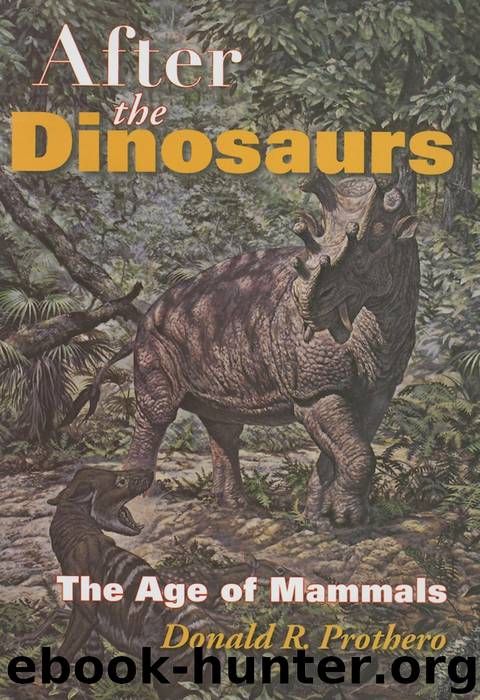After the Dinosaurs by Donald R. Prothero

Author:Donald R. Prothero
Language: eng
Format: epub
Publisher: Indiana University Press
Published: 2018-12-11T16:00:00+00:00
Figure 6.4. (A) Time ranges of major shell types of planktonic foraminifera. Note that many of the shell types vanished during the Oligocene extinctions, only to re-evolve during the Miocene warming. (B) Radiation of Miocene planktonic foraminifera from simple common ancestors in the Oligocene. After Cifelli 1969.
Mass Migrations
The early Miocene was marked by another distinctive phenomenon—the greatest migration of mammals between continents since the early Eocene (Webb 1985; Woodburne and Swisher 1995). Perhaps the warm, mild conditions and abundant vegetation all the way to the Bering Strait made passage between Eurasia and North America easier than ever before. Perhaps tectonic changes made the land bridge more accessible. Whatever the reason, the Bering land bridge was a veritable freeway that allowed many groups of Eurasian mammals to reach North America, and a few from North America to reach Eurasia. By the end of the early Miocene (at about 18 Ma), another land bridge opened: the Arabian Peninsula had collided with Asia, closing off the Tethys to form the Mediterranean. This allowed the migration of animals back and forth from the former island continent of Africa.
The first wave of immigration to North America can be seen in latest Arikareean faunas, which are earliest Miocene in age (the rest of the Arikareean is Oligocene). The most famous locality of this age is the legendary Agate Springs Quarry (now Agate Fossil Beds National Monument) in western Nebraska (fig. 6.5). Discovered in 1906, Agate Springs has produced hundreds of skeletons of early Arikareean fossil mammals over the years, mostly collected by the University of Nebraska, the Carnegie Museum in Pittsburgh, and the American Museum of Natural History in New York. Apparently, the fossil beds were deposited in an ancient river channel and sand bars, where bones washed in by the thousands. One typical slab of bone covering 44 square feet contained 4,300 skulls and bones, suggesting that the Agate bone-bearing layer may have once contained at least 3 million bones from about 17,000 different animals! The most common mammal in the Agate fauna (pl. 4) was the immigrant rhinoceros Menoceras arikarense (once mistaken for the native paired-horned rhinoceros, Diceratherium). Menoceras was the size of a sheep but had a pair of small horns on the tip of the nose in males (fig. 6.6A). Its closest relatives evolved in Eurasia in the late Oligocene and early Miocene, so it was clearly an immigrant from the Old World. Other earliest Arikareean immigrants included two new kinds of weasel-like carnivorans, Oligobunis and Zodiolestes; the beardogs Ysengrinia and Daphoenodon; and the early bear Cephalogale (which was about the size and shape of a raccoon).
Another immigrant was the bizarre chalicothere Moropus (fig. 6.6B), a perissodactyl distantly related to tapirs (Schoch 1989). Chalicotheres first evolved in Asia in the late Eocene and were found in Europe in the Oligocene after la grande coupure. They did not cross into North America until the early Arikareean (27 Ma), and they were never abundant (except at Agate Springs Quarry). Typically, they existed in small numbers for the rest of the early and middle Miocene.
Download
This site does not store any files on its server. We only index and link to content provided by other sites. Please contact the content providers to delete copyright contents if any and email us, we'll remove relevant links or contents immediately.
Sapiens: A Brief History of Humankind by Yuval Noah Harari(14165)
Sapiens by Yuval Noah Harari(5264)
Pale Blue Dot by Carl Sagan(4856)
Homo Deus: A Brief History of Tomorrow by Yuval Noah Harari(4776)
Livewired by David Eagleman(3623)
Origin Story: A Big History of Everything by David Christian(3589)
Brief Answers to the Big Questions by Stephen Hawking(3319)
Inferior by Angela Saini(3209)
Origin Story by David Christian(3117)
The Gene: An Intimate History by Siddhartha Mukherjee(3014)
Signature in the Cell: DNA and the Evidence for Intelligent Design by Stephen C. Meyer(2996)
The Evolution of Beauty by Richard O. Prum(2913)
Aliens by Jim Al-Khalili(2764)
How The Mind Works by Steven Pinker(2695)
A Short History of Nearly Everything by Bryson Bill(2578)
Sex at Dawn: The Prehistoric Origins of Modern Sexuality by Ryan Christopher(2441)
From Bacteria to Bach and Back by Daniel C. Dennett(2423)
Endless Forms Most Beautiful by Sean B. Carroll(2402)
Who We Are and How We Got Here by David Reich(2375)
